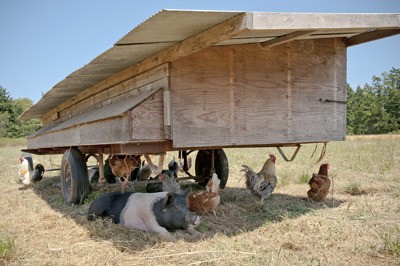Stop by Horse Drawn Farm’s self-serve farm stand on Port Stanley Road or their booth at the Saturday Market in Lopez Village. You’ll find baskets of gorgeous fresh vegetables and freezers full of frozen pork, lamb and beef all raised on this Lopez Island horse-powered family farm.
I’ve admired the abundance Ken Akopiantz and Kathryn Thomas have created year-round for the past twelve years and asked myself many times: “How do they do it?”
I finally sat down with Ken a few weeks ago and he told me what they’ve learned and continue to learn about the planning it takes to run a family farm.
“There’s sort of a romantic and mythical vision of the family farm and farming with horses,” Ken said. “I fell in love with that dream,” he added, laughing. “I was young and idealistic and I saw some horses and thought that farming would be wonderful.”
“And it is wonderful,” he continued, “but there’s only so much planning you can do. As I get older I’ve realized just how frayed the edges are going to be and how much of it really is not in my control. I feel like maybe we’re just getting to the beginning of understanding enough of what we’ve taken on to plan a little bit. We did what we considered planning before but a lot of it was reacting. I feel that finally now we understand enough of the pieces to do some planning.”
Ken explained that the two big pieces—the vegetables and the animals—bring many layers to the planning process. Vegetables need to be planted every week, some in the garden, some in the green house, each with its own schedule and demands. Pigs, sheep, cows need to be bred, birthed, nurtured, slaughtered.
“The more layers you add the more complicated it gets,” he said. “Managing them all is a life-long adventure.”
One kind of planning is figuring out a schedule to spread out the workload over the whole year or month or day so it doesn’t all cram together.
Another more complex kind of planning is sequencing the layers so that they reinforce each other.
Sketching a circle with his hands, Ken explained that at Horse Drawn Farm the vegetables are the focal point with the animals arranged around them, not separate but rather related and reinforcing. Using pigs as an example, Ken said that “waste vegetables go to the pigs, their bedding gets turned into compost which then goes back to the vegetables. We don’t have vegetables that go to waste because we feed them to our pigs and our pigs’ waste becomes fertility.”
In another kind of sequencing, the animals clean the pastures for each other as one species follows another. As they graze, sheep eat parasites that don’t affect them but would affect cows. After the sheep are done with a field, the cows move in. After them, pigs and chickens come in and live together in what Ken calls a pickin’ trailer, the pigs downstairs and the chickens upstairs. This trailer is moved to new ground once a week.
Returning to vegetables, Ken said: “I’ve been working on more of a permanent kind of vegetable rotation. By the end of this year the vegetable beds will be cross-fenced into three sections and the animals will move through each. I kind of have an idea of how I want it to look.”
Though all these plans give a sense of control, Ken wrapped up our conversation by saying: “What I love about it all is the idea that there’s only so much planning I can do. I have to wake up and take the day as it comes. There’s no other way to do it. There will be new bugs and old bugs, new weeds and old weeds, new failures and new successes. And I get up and I do it to watch how it all unfolds. Every year that I’ve watched theoretically I’ve learned something and can plan a little bit more for the next year and do a little bit better job.”




